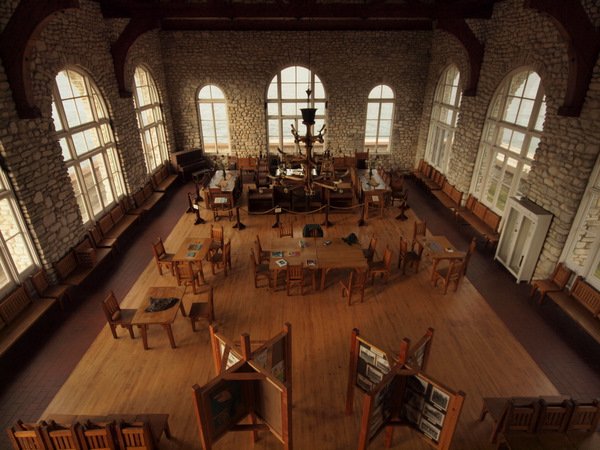Camping at Wisconsin’s Rock Island State Park

It’s almost 8:37 p.m. and I rush with my flashlight on a path through the dark forest to get back to the boathouse. If I am late even thirty seconds, I will miss this appointment. It is an ironic bit of time management in a plot of wilderness where human time is a mockable convention. The dolomite beneath me formed during the Silurian Period, over 400 million years ago, and wave-polished stones, released by winters, water, and Ice Ages, clatter like bones along the shore. Residents have come and gone in an historical blink of an eye.
Coming out of the woods, I make my way past the boathouse out onto the pier. I check my cell phone – which hasn’t seen bars for a couple days and has been relegated to clock duty – and lie down on by back to look up at the heavens. Right on time, a bright light appears, unmistakably not a plane, planet, or shooting star: the International Space Station. It sails through a sea of stars and is gone and I think to myself: There were more people in the ISS over 200 miles above me than there are on this entire island. 8:38 p.m.: The moment is gone and I drift back into the timelessness of Rock Island.
It’s late September, school’s back on, and so camper numbers have declined in the state parks. In fact, at Rock Island State Park on a weekday I happen to be the only camper. For someone looking for peace and solitude, the cover of stars, and the rhythms of Lake Michigan, this park is a paradise in the shoulder seasons — seemingly remote yet only two ferry rides away from Door County, Wisconsin.
The 920-acre Rock Island doesn’t allow vehicles, not even bicycles, and while day-trippers take the half-mile ferry crossing from the eastern shore of Washington Island just to hike the park’s ten miles of trails and visit the 1858 Pottawatomie Lighthouse, those with the time pitch a tent in the primitive campgrounds and stay a few days.
I spend my first full day hiking. Red squirrels chitter at me as I pass, and a deer rustles the underbrush as it leaps away at my approach. One trail circles the island, passing just inside the forest from the lakeshore, but I follow a sandy beach on the south shore passing some modest dunes along the way. Back on the trail lined with wildflowers, I head north on the east side of the island where I stalk a Pileated Woodpecker from tree to tree for a stretch. The heavily wooded island is great for birders and actually sits on a migratory highway. In early June and late fall, flocks of hundreds of birds pass through. Imagine 500 Blue Jays in one wave. The park office has recorded as many as 2,000 Broad-winged Hawks in a single day.
But beyond the island’s natural allure is its historical side. Evidence of a human presence on the island dates back over 10,000 years. The Potawotami were the most recent Native Americans to occupy the island before French explorer Jean Nicolet likely stepped ashore in 1634. In the 19th century for a time there was a fishing village here, and Henry Miner founded the Town of Washington – to include Washington and Detroit Islands – in his home here on the island in 1850. Times were not kind to Mr. Miner; along the trail just past an old stone water tower, I come to a small collection of headstones. Four-year-old Rosalina Miner passed away April 25, 1853, her sister Cecelia just 21 days later. Their tender departing ages on the headstones are totaled down to the number of months and days.
Just north of Rock Island is the widest passage from Lake Michigan into Green Bay, prompting the construction of the first Pottawatomie Lighthouse in 1836. The light was once fueled by lard-oil, then kerosene, before wet-cell batteries were brought in during the Forties. Since 1988, the Coast Guard-managed light has stood atop a separate tower and runs on solar power. But inside the original building is the memory of a keeper’s life. Volunteer docents stay on for a week at a time and give guided tours when visitors stroll onto the grounds. A replica of the 4th order Fresnel lens has been placed back in the light tower.
Behind the lighthouse, steps lead to the water. The light is perched high on a cliff and prior to the construction of a staircase in 1879, the keepers had to walk long distances just to fetch drinking water. Over broken stone I walk the shoreline beneath the white cliffs, stepping over fallen trees and around driftwood. Half a mile later I climb back up to the forest trail and head south to the mowed area around the park office and what is the most impressive structure on the island: Viking Hall, the boathouse.
Built of stone quarried on the island, the boathouse is the first place visitors will identify on the island as they approach on the ferry. Inside, behind tall arched windows and under a high wood-beam ceiling is a hall fit for a Viking party. A massive fireplace occupies one end and a chandelier of horns hangs in the center. Original hand-carved oak furniture features dwarves, runes, and scenes from Icelandic mythology. The unlikely lodge is the creation of an Icelandic immigrant who owned Rock Island as a private retreat from his home in Chicago. Chester Thordarson came to America from Iceland when he was a young child and went on to become a famous inventor, winning a gold medal at the 1904 World’s Fair for his creation of a half-million-volt transformer. (He doubled that voltage eleven years later.) An avid reader, Thordarson’s 11,000-volume library of rare books once filled this boathouse, but has since become the foundation of a rare books collection at the University of Wisconsin. Upon his death, his estate was sold to the state to be preserved as a park.
The boathouse is open and occasionally campers will stop in to play a game of chess, perhaps to look up a wildflower in the guidebooks upstairs, or just to enjoy sun spilling into the great space and the waters lapping in the stone chambers where the boats once moored beneath the wood floors.
After the sun sets and the sky is awash once again with the Milky Way, I head back to my camp to cook a meal over an open fire and listen to Lake Michigan spill into the sands just below my tent site. Thordarson’s private retreat is my private island for a night.
If You Go:
There are 35 campsites with picnic tables and fire rings, but only pit toilets. Modern restrooms are located near the boathouse and campers can purchase firewood to carry back to their sites. Reserve a campsite online at wisconsin.goingtocamp.com
The Rock Island ferry (920-535-0122) runs from Memorial Day through Columbus Day, hourly during the summer, but only three times a day in the shoulder seasons. Call or see the state park’s website. If you are leaving a vehicle parked at Jackson Harbor on Washington Island, you must have a state park vehicle sticker. Ferry fares for campers are $11 for ages 11 and older, $6 for ages 5-10, and free for younger children. (These fares are $9 and $5 for day-trippers.)
Rock Island State Park
1924 Indian Point Rd.
Washington Island, WI 54246
(920) 847-2235
https://dnr.wisconsin.gov/topic/parks/rockisland
Find out when you can see the ISS on NASA’s website at https://spotthestation.nasa.gov/sightings/index.cfm











 ORDER YOUR COPY TODAY!
ORDER YOUR COPY TODAY! ORDER YOUR COPY TODAY!
ORDER YOUR COPY TODAY!